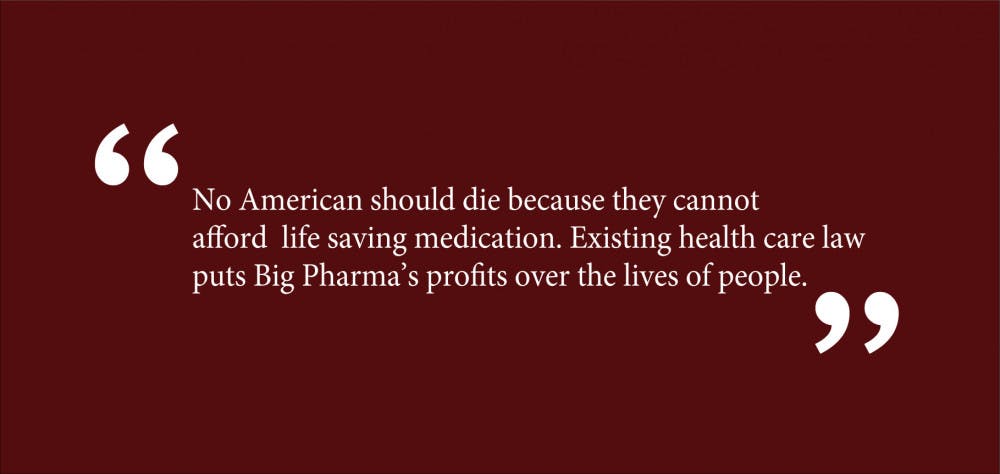By the time Alec Raeshawn Smith’s family had made it over to his apartment in June of 2017, it was too late. He was already dead.
Smith was a Type 1 diabetic, who made the fatal decision to ration his insulin once he realized that he would be unable to afford its $1,300 monthly price tag. His death is just one of many examples of the destructive impact of rising drug prices in America.
Indeed, the sheer cost of drugs in the United States sheds light on what has become a case study in market failure. Research can attest to the exorbitant price tags of prescription medication, which are nearly four times higher, on average, than in other developed nations. And the problem is getting worse. Between 2008 and 2016 alone, the price of the most popular brand-name drugs in this country more than tripled.
These costs weigh on the public in two main ways: First, they squeeze the budgets of millions of Americans who rely on prescription drugs; second, they leave taxpayers to foot the bill for ballooning expenditures for Medicare, Medicaid and the Department of Veterans Affairs.
The solution — which is, unsurprisingly, hamstrung in Congress — is clear. Medicare needs to leverage the billions in revenue it provides for pharmaceutical companies in order to negotiate lower drug prices. Doing so would mean enormous savings for consumers and the government alike.
But consider first that Medicare wasn’t involved at all in the prescription drug industry until 2003. That was when the Medicare Modernization Act established what we know as Medicare Part D. Under this program, Medicare established contracts with hundreds of insurance providers, who offer insurance plans — bankrolled by the government — that cover prescription drug costs for millions of senior citizens.
But there’s a catch. Pharmaceutical companies knew that this program would turn the government into their largest customer overnight; this would put these industry giants at the mercy of Medicare when it came time to set prices. Big Pharma’s industry lobbyists thus worked hard to slip the “noninterference” clause into the MMA, banning Medicare from being involved with price negotiations, from determining the coverage status of medications and from instituting reimbursements. Instead, these abilities fell to the myriad of insurance providers that offer Medicare Part D plans.
It was genius, albeit insidious: The enormous influence held by the pharmaceutical industry’s largest buyer was divided among hundreds of players, all competing with one another and unlikely to hold manufacturers accountable for price hikes and other monopolistic behaviors. If a given Part D provider threatened, say, to stop covering a drug because of its sky-high price, its manufacturer would have hundreds of other providers to choose from. Big Pharma successfully turned the system into a seller’s market.
Allowing Medicare to negotiate prescription drug prices would concentrate leverage in a single entity, paving the way for real concessions from large firms. Medicare accounts for about one third of their revenue; pharmaceutical companies would have no choice but to negotiate directly with Medicare to earn spots on a national formulary — the list of drugs covered by Medicare plans.
Indeed, according to estimates by the Congressional Budget Office, H.R. 3, the most recent congressional proposal to cede control of drug price negotiations to Medicare, would save over $350 billion by 2029. Those who worry that lower drug prices would reduce the incentive for innovation in pharmaceutical research should recognize that even a fraction of the money saved exceeds the research and development spending of every major pharmaceutical company combined. The government could put some of those billions toward research grants in both the private and public sectors to ensure that new medications continue to come to market, while still having funds left over to put toward solving a plethora of other social issues.
The lower costs of prescription medication would spill over into non-Medicare insurance markets as well, as H.R. 3 demands that renegotiated prices are offered to private sector buyers. This means lower costs for everyone — a welcome change in a country where the aggregate cost of health care is projected to hit $6 trillion by 2027.
No American should die because they cannot afford life-saving medication. Existing health care law puts Big Pharma’s profits over the lives of people like Alec Raeshawn Smith. It is time for that to change.
Arjun Shanmugam ’23 can be reached at
arjun_shanmugam@brown.edu. Please send responses to this opinion to
letters@browndailyherald.com and op-eds to opinions@browndailyherald.com.



